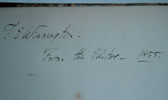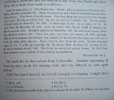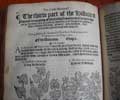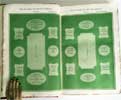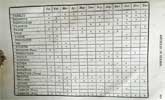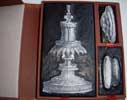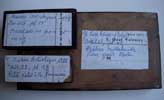LE JARDINIER FRANCOIS.
QUI ENSEIGNE A CULTIVER les Arbres, & Herbes Potagers; Avec la maniere de conserver les Fruits, & fairetoutes fotes de Confritures, Conserves, & Massepains. DIEDE AUX DAMES. DIXIEME EDITION. Augmentee par l'autheur de plusients ex-periences qu'il a faites. [a printer's colophon] A PARIS, Chez NICOLAS LE GRAS, au troi-sieme Pillier de Grand'Salle, du Palais a L, couronnee. [a single long line] M. DC. LXXXIV. AVEC PERMISSION.
1684. Thick 8vo. 1 fep. Book Title page outlining the 3 Tomes. Tome 1: Le Jardinier François. [the French Gardener]. Title page. [1] Epistre aux Dames 10p.Preface 5p. [2] Frontispiece of a garden scene. 1-309. 6p. (miss-numbered) The Table. Tome 2. Les Delices de la Campagne. . [the Delights of the Countryside]. [1] Frontispiece of Garden workers. [1] Epistre aux Dames 4p. Preface 2p. [1] 2nd Frontispiece of a Baker. Title page. 2-321. 322-328 The Table. Title page: Tome 3. La Maniere de Cultiver des Arbres Fruiterers. [the Way of Cultivating Fruit Trees]. [1] Dedication 2p. Preface 22p. 1-126. [1] 2nd Title page. Instructions pour les Arbres Fruiterers. [Instructions for Cultivating Fruit Trees]. [1] Le Libraire au Lecteur 2p. 131-238. Tome 4. Title page: Traité des Chasses, des la Vénerie et Fauconnerie. [Treatise about things Venery and Falconry]. [1] 241-282. Table des Chapitres. 1fep. Some slight age dusting throughout. Bound in original full dark brown leather with raised bands on spine and a nice patination. Small piece of leather missing from back cover. Slight cracking to joints but holding well. Overall good condition.
- Bonnefons was a 17th century French writer who was also the 'valet de chambre' of Louis XIV. In the 1650's He published two very important cookery books; 'Le Jardinier François' and 'Les Delices de la campagne' which marked a major turning point in French cooking. In Melissa M. Wittmeier's well researched article online titled 'The Art of the Table in Eighteenth-Century France', she informs us that French cuisine changed very little during the Middle Ages. Even during the Renaissance when a type of more refined cooking was introduced, the French diet remained as it was and dominated by certain cereals and legumes for the poor, and by spicy, boiled meats for those who could afford them. Vegetables were generally considered indigestible with little to no health benefits attributed to them. During the reign of Louis XIV, [The Sun King] all of that changed. The king's preference for certain delicacies, his love for his garden and for the fruits and vegetables that it produced, set the stage for the culinary revolution and standards for fresh produce that would inspire so many great French Chefs still to follow in the future. When Louis XIV died in 1715, doctors noted upon conducting his autopsy that his stomach was three times the size of that of the average adult. Bonnefons noted in 'Les Delices de la campagne', that for the presentation, "the middle of the table will be left empty, since the master of the house will have difficulty in reaching it because of his girth." Several pages later, Bonnefons documented some "instructions for feasts"; the eight courses of the feast took more than six pages to describe and included so many plates that the Sun King's eating habits, his sumptuous and excessive repasts, his extravagant and lavish entertainment, became legendary. Bonnefon's books also elaborate in print a major change in cookery, where he emphasized cleanliness, complementary flavours and simplicity in food preparation. His oft-repeated quote; “Let a cabbage soup be entirely cabbage. . . and may what I say about soup be a law applied to everything that is eaten.” Because of Bonnefons close proximity to the King and his rare abundant gardens at Versailles, and also being a very good writer, this is a historically important book documenting Court cuisine and a practical progressive development in French cookery that ultimately was a major tenet that helped establish it as one of the world's major cuisines.






click on image to enlarge

Antiquarian category
ref number:
11294 

